Director’s note: Last weekend, I had the honor of giving a presentation at the first annual Remigration Summit in Milan, Italy.
Totalitarian Antifa groups tried to get all venues to reject the conference, but to no avail. At least three hundred participants gathered together safely thanks to the quick wit and communication of the organizers.
I was mildly disappointed that in order to hear “Bella Ciao,” I had to search YouTube later and found a video of protesters singing an hour away. Ironically, “Bella Ciao” was originally a protest song for farming women who were facing atrocious working conditions—something Remigration can specifically prevents as I illustrate in the presentation.
But overall I was vastly more grateful for the police protection for all attendees and great security provided by the organizers. I’m incredibly grateful for Matteo Salvini’s public statement, “I believe in freedom of speech for everyone,” and for the Italian government who demonstrated Italy is not only a beautiful country, but one that respects freedom of speech in practice.
It was energizing to be in a room with several political parties represented: Lega of Italy, CHEGA of Portugal, the Alternative for Germany, the Forum for Democracy from the Netherlands, Vlaams Belang from Belgium, the FPO in Austria, the National Party of Ireland, the Homeland Party of the UK, and a fellow Republican from the US. Everyone was there to contribute to shared strategies of legal, humane, and practical Remigration.
As for my part, I was asked to give a summary on the economics of remigration. My hope is that every participant can use this information to build a practical plan for their country. So I’m sharing my presentation notes with citations below. If you have questions, please don’t hesitate to email me at cyan@whitepaperspolicy.org. And don’t forget to upgrade to a paid subscription to support more analysis and proposals.
To echo the chants of the audience: “Save our nation! Remigration!” The time is now.
By Cyan Quinn
We heard a lot at this conference about the moral arguments for remigration which are probably more compelling—we shouldn’t need to cite practical reasons to desire our own survival as a people group—but at the end of the day, we need to know that remigration is financially possible. That’s when it becomes “real.”
That seems incredibly unromantic, once you show that an idea is practical, that’s when we can truly channel all this incredible energy into actionable policy. So I’m here to tell you it’s possible and we’re going to save a lot of money doing it.
To address the elephant in the room, you may wonder why an American is yapping at you. White Papers Policy Institute is not just me; we’re a team of analysts and academics from several Western countries who came together over a love of our Western Civilization. One of the things I think is very special about this conference is that is signifies a recognition that we’re all in the same boat (or rather, they’re on small boats coming to all of us). We’re facing this problem as The West, and we can come together as The West to solve it.
So, how do we save our civilization?
“We can’t restore our civilization with somebody else’s babies.” – Former Rep. Steve King (R-Iowa) tweeted this in support of Geert Wilders in the Netherlands in 2017.

The media flipped out because everyone on the inside knows what that means. People create the civilization we live in. It’s not a set of Principles. It’s not magic dirt. It’s us. Demographics is Destiny. If we like living in Western civilization, we have to care about the continuation of the people who created it.
So we evaluate and create every policy proposal through the lens of “is this good for that core demographic?”
With that in mind, over the next few minutes, we’re going to go over the 5 top myths about migration and the economy and we’ll show you 2 examples how even paid, voluntary remigration will improve the financial outlook of your countries and your people.
Myth #1: Immigration increases the GDP.
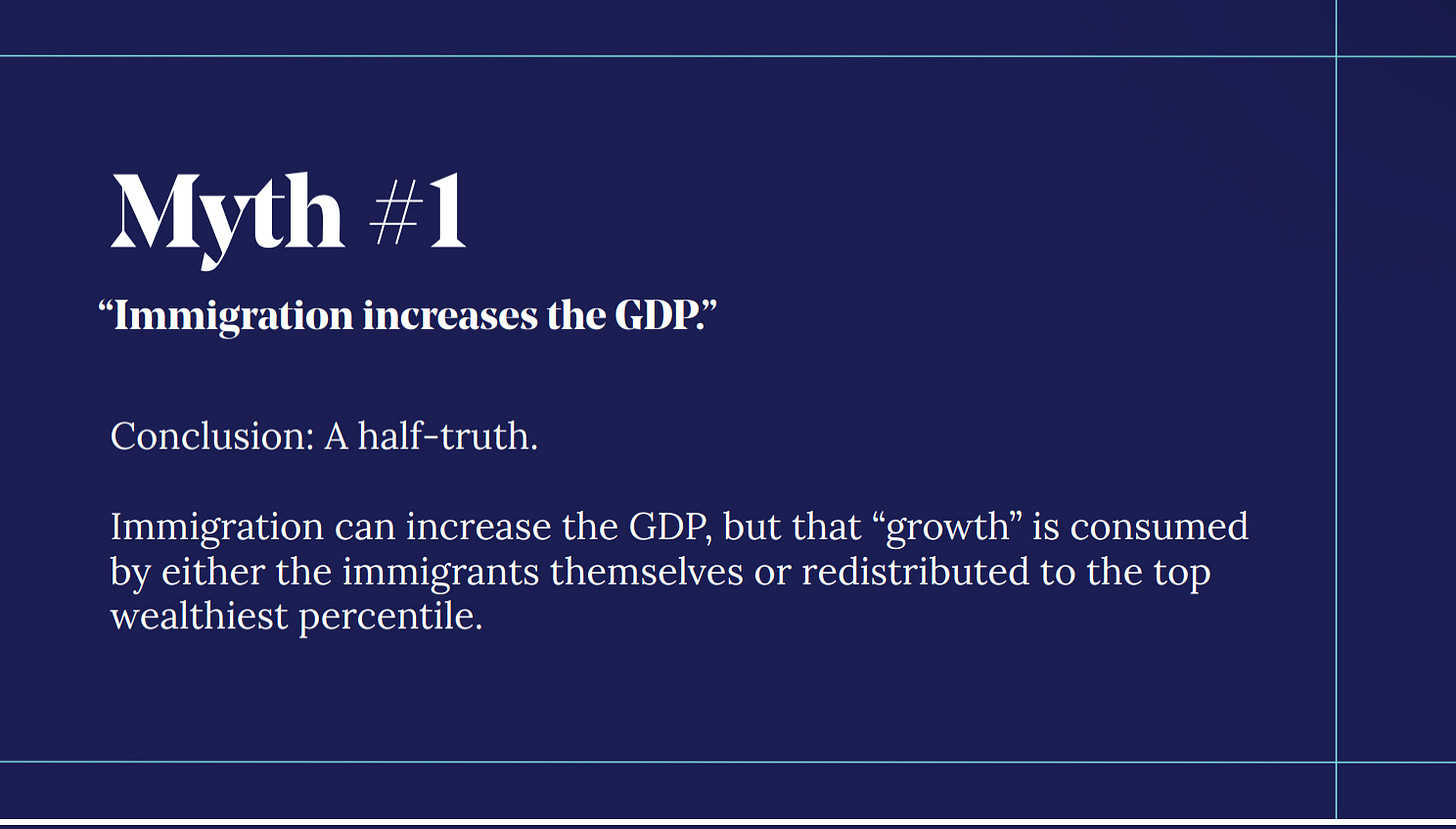
Conclusion: A half-truth. Immigration can increase the GDP, but that growth is consumed by either the immigrants themselves or redistributed to the top wealthiest percentile.
In crude Marxist terms, this means wealth redistribution from labor to capital.
- A GDP increase due to immigration does not mean a better life for the native-born!
- The famous and highly cited 2017 report by the National Academies of Sciences, Engineering, and Medicine estimated that the actual “benefit” of immigration to the native-born could be $54.2 billion a year. But this “benefit” is calculated as the reduction in wages of native workers who are in competition with immigrants by $439.4 billion annually. The gain to businesses is $548.1 billion. This creates a net “benefit” of $54.2 billion to natives. How many people still consider this a “benefit”? Whether or not most people would consider this a benefit, however, might be a slightly different story. Still, even this is probably overstating the ‘benefit’ of migrants, as it cannot account for the various indirect impacts that this large-scale bottom-up wealth redistribution has. For instance, natives whose prospects are hurt by migrants and leave their local area are also probably more likely to end up on welfare afterward, but the formula for calculating the immigrant surplus does not capture this, so in practice, the immigrant surplus is closer to $0 or even negative.
- This discovery was also made almost 30 years earlier by Harvard Economist George Borjas, who showed that immigrants drove down the wages of native workers by $244.93 billion adjusting for inflation since the study.
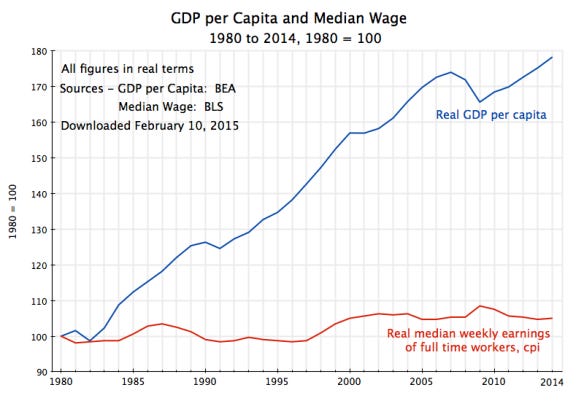
(Graph credit: Harvard Economist Roland Fryer of aneconomicsense.org)
- Between 1945 and 2010, real incomes of the lower working class Americans dropped by 6% whereas the top 1% increased by 312% and the top 0.01% ballooned by 431%.
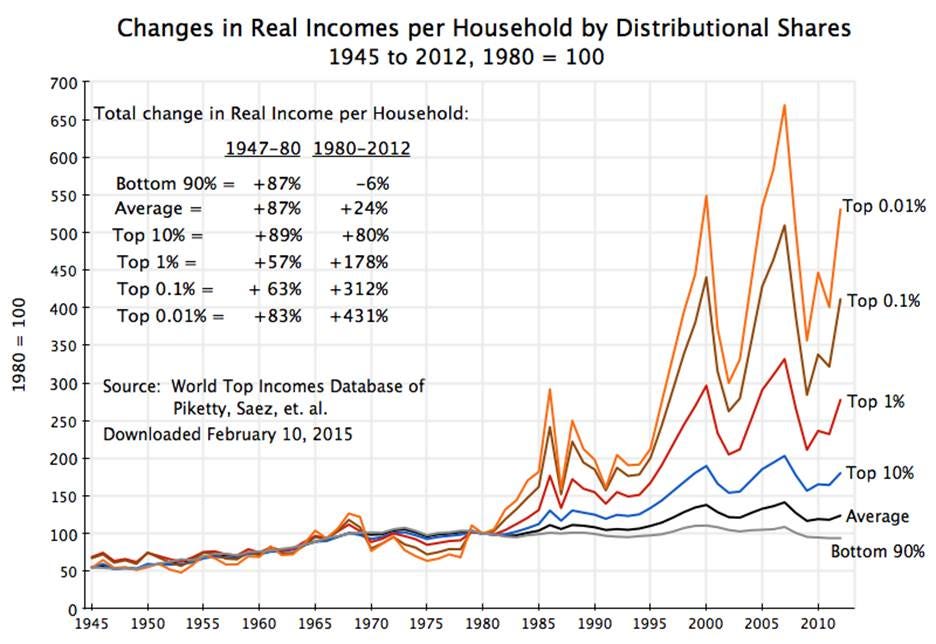
Over the same time period, the foreign-born population in the US shows the same remarkable curve.
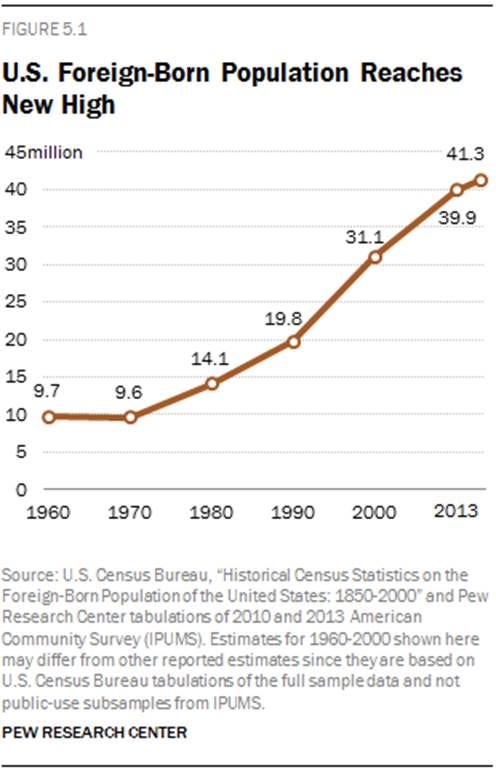
I’ll never forget the day the Heritage Foundation came to give a presentation at my university on the merits of the total free market economy. They told us how great it was that children in China could work in the Apple factory, be productive with their time, and contribute to their family’s income, as if they had nothing better to do as children. [An aside: I don’t think the Heritage Foundation holds this view anymore and their position on China has certainly changed since 2009.]
In the rural town of Beed India, female farmers are paid $3 a day. One in five report being pressured into having hysterectomies because menstruation interferes with their productivity.
We need to ask ourselves, is this the kind of society we want to live in?
Moreover, it is not necessary to increase the GDP. For example:
- Japan is 97.8% Japanese as of 2024 and averaged 1.2% economic growth for the last 20 years
- Poland is 98.5% Polish as of 2021 and averaged 3.94% economic growth from 1995-2024
- Sweden averaged 2% growth between 1969 and 1980 when it was the most ethnically cohesive country in the world.
Myth #2 Employers won’t be able to hire native workers.

Conclusion: False. Native workers still make up the bulk of jobs in construction and agriculture. Unemployment among foreign nationals is swept under the rug. And economic growth relies far more on innovation than cheap labor.
- In Michigan, 82% of construction workers are demographically American.
- Even in Texas, a state with high immigration, Whites are 57.5% of construction workers.
- In the Netherlands, 84.7% of construction workers are ethnically Dutch.
- In Germany, ethnically German workers make up 60% of construction jobs, 60% of transport jobs and 65% of engineers.
- In the US, ethnic Americans still make up 45% of the agricultural labor market.
- Foreign workers do however dominate cleaning at 60% immigrant in Germany. But is this worth it?
Unemployment of foreign nationals:
- In the US, 34% of illegal immigrants of working age are not engaged in the labor market. (More detail and citations here. )
- In Austria, 30% of 15-64 year old foreign nationals are not engaged in the Austrian labor market. This is 625,500 people.
- In Britain, there are approximately 1.7 million working age non-UK citizens unemployed, economically inactive, and living off the welfare state. Not including foreign students, the native British taxpayer has spent more than 23.8 billion pounds on economically inactive migrants since 2020 – equivalent to 30% of the UK’s 120 billion 2023 budget deficit.
Lastly, the economy relies more on innovation than cheap labor. Simply put, the Japanese economy with virtually no immigration, outperformed the US consistently since 1955 until the oil crisis of 1973 through investment in infrastructure, innovation, and export.
Let’s go back to farming because the thing you hear the most is that “the vegetables will rot in the fields.”

Let me describe for a moment the Vidalia onion raids of 1998. In 1998, Immigration and Naturalization Service agents raided several farms in south Georgia, rounding up illegal workers who were harvesting highly prized Vidalia onions. It only took two days for four Georgia congressmen to complain to the INS about a “lack of regard for farmers.” The legislators believed the immigration and naturalization service “does not understand the needs of America’s farmers.” Our managing editor James Fulford wrote about the incident at the time for the VDARE Foundation and described the real needs of America’s farmers such as this:
- America’s farmers need to be paying higher wages so they can hire Americans.
- They need to mechanize their operations.
- Some of them need to be fined or jailed.
This may sound harsh, but in America, we have something called RICO Act which prosecutes “enterprise crime.” This is where your profit structure is dependent on illegal activities. In this case, the profit structure is dependent on illegal immigration. Again, immigration privatizes the profits and collectivizes the costs.
Now, I have sympathy for and know a lot of independent farmers. It is the case farming has a very slim profit margin. I have a friend from the small town of Linden, Washington who explained how mechanization makes it impossible for family dairy farms like hers to compete with mega corporations because they can’t afford to buy the robot milkers.
But rather than demanding more immigration, we need to be demanding subsidies for automation. We already have incentives for solar power, electric cars. Why not automation? The biggest environmental impact in the West is not cow farts. It’s mass migration. The Sierra Club was paid $100 million dollars to shut up about it). But it is the year 2025. We have the internet and we know better.
Another example is the case of the dairy bailout in America during WWII. The phrase “government cheese” comes from the time the US needed to save the dairy industry. They did so by buying a vast amount of milk from struggling dairy farmers and turning it into highly processed cheese food which they stored in cheese caves and then rationed out. Turns out people liked it, and this is the origin of American Cheese. But the point here is that the government can and has been creative in the past. We can do so again.
Myth #3 We need immigrants to prop up social services:

Conclusion: False. Studies have consistently shown that non-Western immigration costs the state more than it can reap in taxes.
- In Sweden, a 2017 government investigation found that immigrants will double the state cost of pensions even after taking into consideration taxes paid by these immigrants.
- A 2019 paper found that at current levels of integration and labor force participation immigrants did not contribute to compensating for an aging population but instead drew more benefits than would otherwise need be paid out.
- Western or non-Western ethnicity matters. A famous Danish tax study found Danes and Western immigrants contributed positively to taxes while non-Western immigrants never made positive annual contributions as a group.
- The Dutch study by their government’s own Central Planning Office found that an immigrant to the Netherlands who arrives at age 25 and stays will have a net negative lifetime cost of 43,000 Euros while an immigrant descended child born in the Netherlands will have a net negative lifetime cost of even more—just under 100,000 Euros.
- In a Dutch paper titled “Borderless Welfare State: The Consequences of Immigration for Public Finances,” researchers found that between 1995 and 2019 immigrants led to 400 billion Euros in public sector losses through spending and between 2020-2040 another 600 billion will be added to the total. The Dutch national debt is currently 491 billion Euros; this means that 81.4% of national debt could be attributed to spending on immigrants.
Myth #4 Remigration is too expensive.

Conclusion: Western economies cannot afford not to initiate remigration policies.
Mandatory remigration policies should already be in place for anyone who is here illegally or has committed a crime. Using systems such as e-Verify and simple visa cancellation are the first steps toward a sane immigration system.
Visa cancellation is by far the quickest and most effective strategy. During the COVID-19 pandemic, the German visa system was largely stopped and inflow into the country dropped dramatically. In the UK, the British government suspended visa issuance in 2020 by closing all of its biometric processing centers both domestically and abroad. In the US, no states closed their borders, but many tribal governments recognized the power available to them and completely closed their borders to non-residents.
However, even the cost of paid incentives over a span of 12 years will cost dramatically less than the perpetual net drain on Western economies caused by non-Western migration.
Let’s take for example some of our paid remigration proposals:
The American Repatriation Policy Platform:
In the US, the Trump administration is offering a stipend of $1,000 plus reasonable expenses to illegal immigrants who opt to self-deport. The projected cost is $4,500 vs. $17,121 it costs to deport someone by force. While this is clearly a move that deserves support, the more important shift is that we can begin looking at immigration and furthermore, remigration, with objective, fiscal common sense. Remarkably, even this has its opponents who claim we should simply fine illegals $5,000 each and allow them to stay in the country. Opponents cite the left-wing American immigration Council which calculates a mass deportation operation to cost $315 billion.
However, researchers at the Manhattan Institute discovered that just the new illegal immigrants since 2021, 8.7 million people, will cost the American taxpayer a staggering $1.5 trillion or $68,000 for each illegal immigrant over the course of their lifetimes.
(Note: see platform for citations on each figure below.)
Regarding legal immigration, we propose a $72,000 repatriation payment
- This represents 150% the median American income or
12 years earnings in Mexico
3.5 in Japan
33 years in Ghana
- The total projected cost would be $3.6 trillion over the course of 12 years or $300 billion per year.
Savings:
$50.65 billion in housing assistance that went to non-western families representing 75.6% of the total budget)
$100 billion in nutrition assistance representing 60.2% of the total budget
- $527.4 billion in Medicaid representing 60.5% of the total budget$125.58 billion on prisons, policing and incarceration, 69% of the total budget
$80.5 billion only to educate the children of illegal aliens
$14.4 billion in grants, contracts & other financial assistance to Puerto Rico.
This is $898 billion per year or three times the annual proposed cost of the repatriation policy platform.
The costs of supporting an increasingly diverse population is perpetual in nature. Repatriation costs are temporary.
The British Remigration Policy Platform:
(Note: see platform for citations on each figure below.)
In the UK, we recommend a one-time payment of £65,000 to repatriate.
This figure represents slightly less than double the median annual earnings in the UK. More importantly though, this represents:
§ 40 years of earnings in India
§ 10 years of earnings in the Caribbean,
§ 50 – 80 years earnings in some African states.
Moreover, the creation of a Home Office for Remigration would keep administrative fees within the local economy.
If we assume 50% of voluntary repatriates to opt for paid remigration schemes (47% of minority households in the UK find it difficult to afford their rent or mortgage payments according to the Institute of Race Relations).
The total cost adds up to £118.6 billion over 12 years or roughly £9.885 billion per year.
Savings:
- £4.3 billion which the UK currently spends to support illegal immigrant and refugee arrivals.
- £14.7 billion per year on policing: In the fiscal year 2022-2023, the UK spent £17 billion (pop 56mil 81.7% British) whereas Poland (pop 40mi, 98.8% Polish) spent £2.3 billion. (Pay difference plays only a small role. Average officer in Poland makes £21,800 a year. UK average constable makes £23,556 according to the UK police federation. The difference is demographics.
- Prisons £1.2 billion: 28.2% of current prisoners are non-British. The government spends £48,409 for each prisoner it houses, therefore the cost of the non-British prison population (24,766 of the current 87,869 people) is some £1.2 billion annually.
- NHS £52.35 billion: In 2021, the NHS spent £4,188 per person as part of the £280.7 billion NHS budget. Non-Britons of non-Western origin make up 18 – 20% of the UK population, the NHS is spending upwards of £52.35 billion every year on the non-British population.
Overall, paid remigration would cost the UK £9.885 billion. By removing this segment of the population, the UK would save £72.55 billion per year. Net gain of £62.665 billion per year.
The current national deficit in 2024 was £61 billion.
Even paid remigration can wipe out the national deficit.
Myth #5 Migrants do not want to leave.
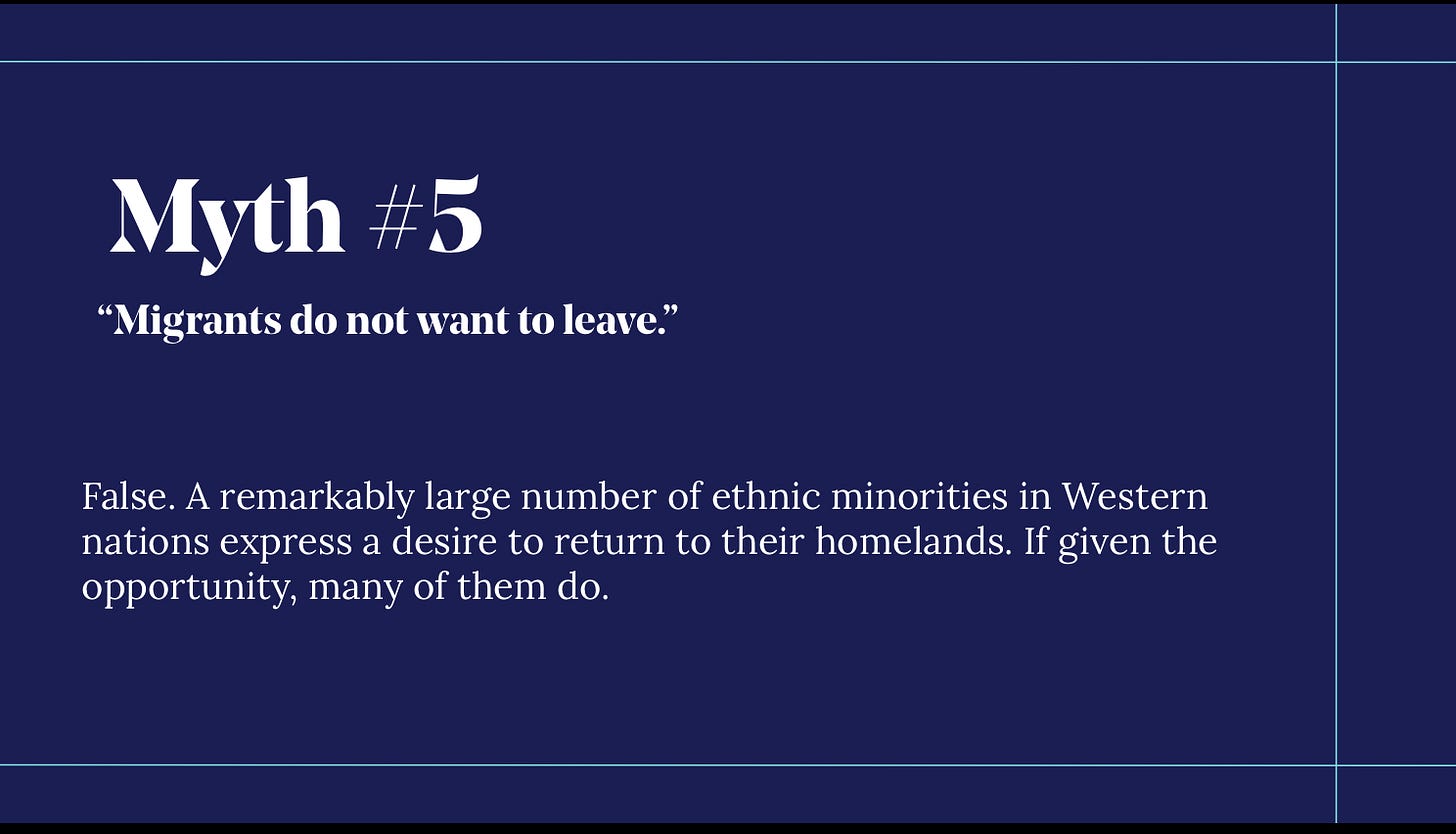
Conclusion: False. A remarkably large number of ethnic minorities in Western nations express a desire to return to their homelands. If given the opportunity, many of them do.
- 66% of non-British ethnic minority people in the UK aged 16-34 were considering or actively planning to leave the UK.
o Less than 20% of those who wanted to leave cited racial discrimination.
o However 39% stated that Britain suffered from “bad vibes.”
- In the US, almost half of the 1.1 million illegal immigrants deported in Operation Wetback in 1954 were voluntary, and that was without a stipend.
- Monmouth University expects 45-51% of those with non-Western origin in the US will take a voluntary paid repatriation payment.
- 45% of People of Color in the US would move abroad and settle in a foreign country if free to do so. This increases to 51% among people aged 18-34.
- 30% of African Americans who visit Africa have either relocated or wish to relocate permanently. PEW research in 2023 revealed that 26-30% of Asians in the US would consider relocating to their ancestral homelands. (The photo in this slide is of Tony and Ayo. American expat Entrepreneurs who run a website called Expat Life Ghana and their journey was featured in a recent HBO documentary. I enjoy watching their YouTube channel and one of the things Tony said which stuck with me is that when he was in Texas, he was a “black man.” Whereas, in Ghana, “I’m just a man.”)
- Research by PEW, released in late 2023, also shows that a large share of Asians in the US, some 26%, would consider moving to their ancestral homelands. This includes 14% of US-born Asians who would move back to their ancestral homelands, representing about 1.4 million people. Further, 30% of foreign-born Asians would move back to their ancestral homelands if given the opportunity
- Only 45% of Asians consider themselves to be in any way American and 51% of Asians in the US claim to be friends only with members of their own race.
- In Austria, according to the Austrian Integration report, 26% of immigrants in Austria do not feel they belong in Austria. Among immigrants who have been in the country less than five years, 46% do not feel they belong. If we take the average of these two figures, we can assume 36% of second-generation immigrants do not feel they belong and may remigrate gladly if given the opportunity to do so.
Bonus Myth #6 “It’s too late.”

False. But if we don’t act now, it will be.
The vast majority of immigrants in Western nations are still first and second generation. This means many In Britain, 80% of the foreign born population arrived post- 1991. And 50% of Britain’s non-Western population is foreign born.
More than half of non-ethnically Dutch people living in The Netherlands are first or second generation.
Visa cancellation and a review of dual citizenship would increase the Dutch share of the population by 12.5 points. The Netherlands could be 80.5% Dutch again!In Britain, 80% of the foreign born population arrived post- 1991. And 50% of Britain’s non-Western population is foreign born.
More than half of non-ethnically Dutch people living in The Netherlands are first or second generation.
Visa cancellation and a review of dual citizenship would increase the Dutch share of the population by 12.5 points. The Netherlands could be 80.5% Dutch again!of them still hold citizenship and family ties in their home countries.
- In Britain, 80% of the foreign born population arrived post- 1991. And 50% of Britain’s non-Western population is foreign born.
- More than half of non-ethnically Dutch people living in The Netherlands are first or second generation.
- Visa cancellation and a review of dual citizenship would increase the Dutch share of the population by 12.5 points. The Netherlands could be 80.5% Dutch again!
Remigration is a winning issue. Your hard work, as activists, writers and media producers, and political party members, made this a policy proposal we are crafting here today.
(Read more including links to citations here:
40% of Americans were willing to tell the SPLC that they think The Great Replacement poses a threat to Whites and White Culture. Broken down further, this includes:
o 63% of young Republican men
o 61% of Republican women
o 54% of young Democratic men (This is an interesting figure – Remigration can be bi-partisan.)
- In Canada, 45% of Canadians believe there are too many visible minorities in their country.
- In France, 69% think there are too many immigrants in France.
- 63% of the French do not “feel safe anywhere” in their own country.
- Nearly half of all Frenchmen do not believe that the children of immigrants can truly be French.
- In Australia, 70% of Australians want less immigration.
- 61% believe Australia has “enough diversity” and needs to encourage Australian identity.
Pro-migration arguments are all the same: “Migration is inevitable.” “We’ve always had it, and with the improvements in technology, people will move about even more.” “There’s nothing we can do to stop it, and we need to welcome a rainbow of people into our countries.” And of course “But the FOOD!”
We know these are lies. As the previous stats show, mass migration from the third world is quite a new phenomenon.
Second, migration occurred directly contrary to the will of the people. In the US, it is the case that every time the American people were offered more migration from the Third World, we rejected it.

So how did it happen? In the US, the Hart Celler act was passed on lies. We were promised that the ethnic mix of the country would not change.
The Chairman of the Senate subcommittee hearings on the Hart Celler Act, Edward Kennedy, said in his opening remarks:
What the bill will not do: First, our cities will not be flooded with a million immigrants annually. Under the proposed bill, the present level of immigration remains substantially the same . . . Secondly, the ethnic mix of this country will not be upset . . . Contrary to the charges in some quarters, S. 500 will not inundate America with immigrants from any one country or area, or the most populated and economically deprived nations of Africa and Asia . . . In the final analysis, the ethnic pattern of immigration under the proposed measure is not expected to change as sharply as critics seem to think. [Lawrence Auster, The Path to National Suicide: An Essay on Immigration and Multiculturalism, page 12 1990, Monterey, Virginia, The American Immigration Control Foundation]
Replacement level migration is not “inevitable” and “progress” does not mean globalization. Our replacement was a deliberate policy choice, and we the people can choose to make deliberate policy to shape our own future – for ourselves and our posterity.
Complete Slide Deck Here.


